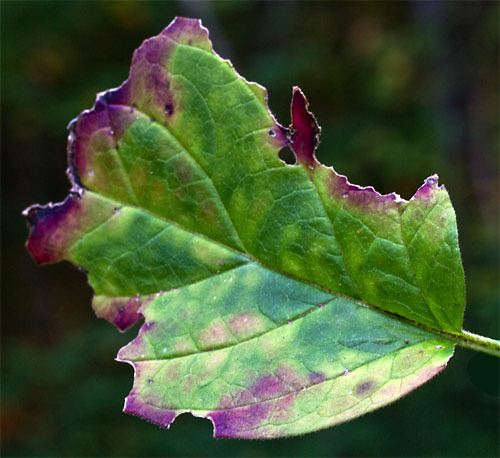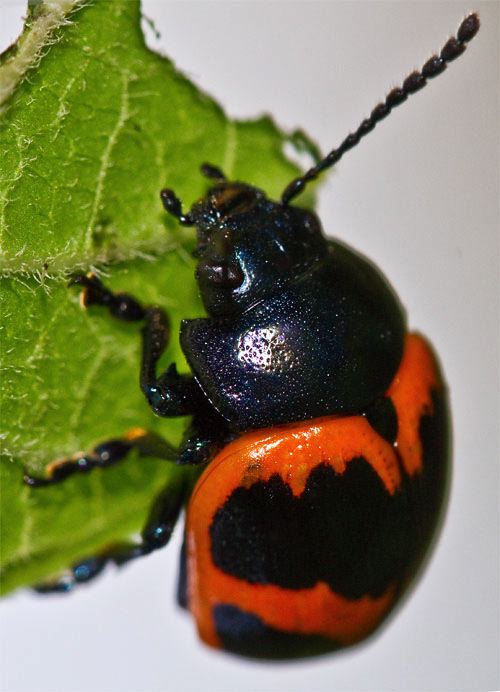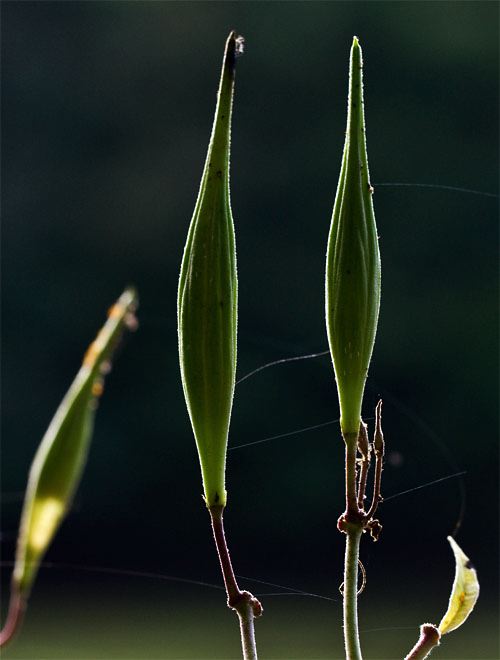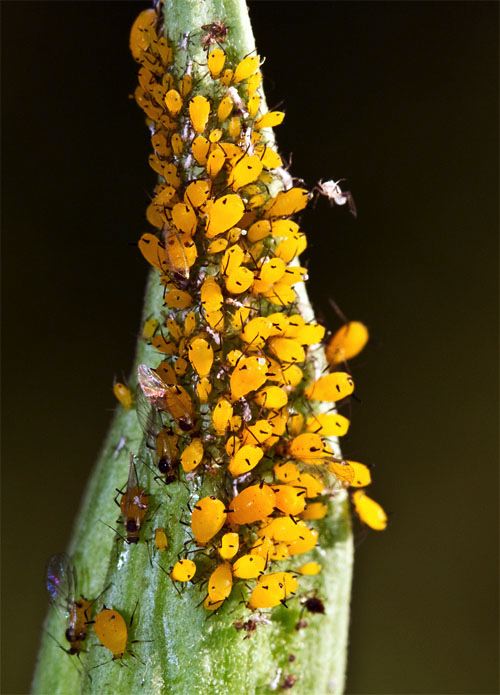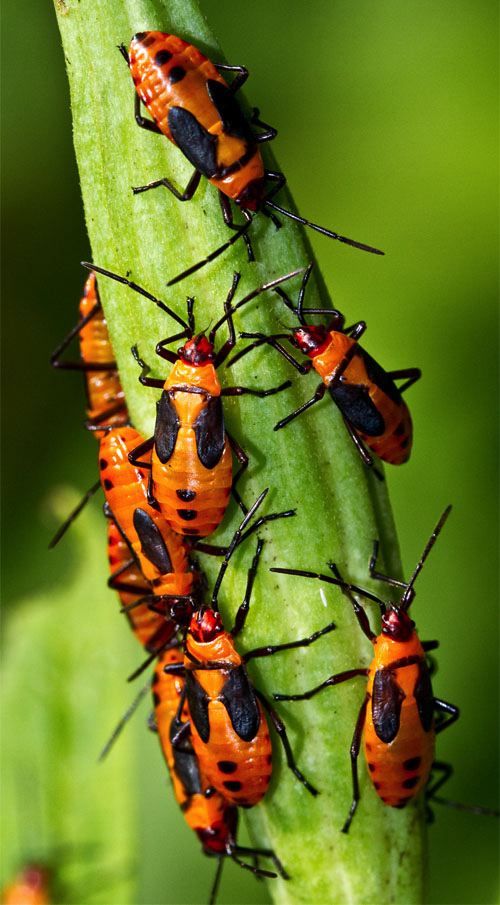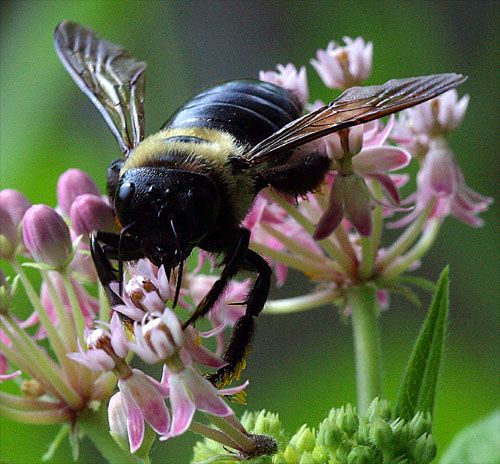|
|
|||
|
(Back to Preceding Week; on to Next Week) |
|
All text & photos © Hilton Pond Center ASSAULT ON SWAMP MILKWEED We take great satisfaction from Hilton Pond Center's small but growing population of Swamp Milkweed, Asclepias incarnata (midsummer bloom, above), and we've written about it in several earlier installments. We confess we had nothing to do with the plant's presence here other than we have a pond whose margins we do not cut and around which we do not apply herbicides, pesticides, insecticides, or other industrial poisons. Perhaps a dozen years ago the first Swamp Milkweed plant appeared on a muddy bank of the small impoundment. We have no idea how it actually arrived, but we were enthralled by the lavender-pink blossoms it produced and kept close eye on it. Through the years that first plant--thanks to a variety of native pollinators--flowered and produced pods that, in turn, disseminated winged seeds to various other spots around the pond until. These days we have several thriving colonies that host an increasingly diverse number of insects, so many this year the Swamp Milkweed seems under assault.
All text & photos © Hilton Pond Center Early on, our original Swamp Milkweed cluster grew unmolested and during midsummers was a nectaring site for such butterflies as the Eastern Tiger Swallowtail, Papilio glaucus (above). One year, however, we noticed a few taller milkweed plants had gotten "nipped in the bud" by White-tailed Deer that wander through Hilton Pond Center. We suspect only one or two young deer tried browsing milkweed flower heads before realizing the plant doesn't taste very good; after all, many milkweed species are laden with sticky white sap containing alkaloids and cardenolides that--at the very least--make some animals throw up.
All text & photos © Hilton Pond Center Perhaps the best-known example of milkweed toxicity involves Monarch butterflies, Denaus plexippus (female above, on a Swamp Milkweed; note also the similarly colored but much smaller Ailanthus Webworm Moth, Atteva aurea). Monarch adults do indeed feed on milkweed nectar--
All text & photos © Hilton Pond Center There's no question a Monarch caterpillar--whose final instar is nearly 2" long--can be quite ravenous on milkweed, sometimes stripping a plant of all its foliage and leaving behind nothing but a naked stem. More often the hungry larvae consume only a portion of any given milkweed leaf (chew marks, above), nonetheless reducing the leaf's photosynthetic ability and possibly leading to its early demise. We never observe very many Monarch cats on our Swamp Milkweed plants on the banks of Hilton Pond, but they do have an impact on foliage. By this time of year nearly every milkweed leaf shows some degree of caterpillar damage.
All text & photos © Hilton Pond Center A few months ago we wrote about another insect we discovered nipping at our Asclepias, none other than SMLB--the Swamp Milkweed Leaf Beetle, Labidomera clivicollis (above). This orange and black beetle showed up this year for the first time around Hilton Pond and immediately went to work eating flower heads on our Swamp Milkweed. These half-inch-long insects must have been doing something else--i.e., reproducing--because we also discovered their larvae chewing on milkweed leaves. These immature beetles had less impact than the much larger Monarch caterpillars, although adult Swamp Milkweed Leaf Beetle had potential to do their host plant far greater harm by eating its flowers. The milkweeds have rebounded nicely, however, replacing beetle-damaged florets with new ones that ended up getting pollinated and making quite a few pods in 2010.
All text & photos © Hilton Pond Center These awl-shaped two-inch-long pods are all-important to Swamp Milkweed because they provide its principal means of propagation. (This species may also make rhizomes that can spread and produce new stems in later years.) As shown on the background pod in the photo above, Swamp Milkweed is frequently infested by a third kind if insect, in this case a cluster of little yellow-orange Oleander Aphids, Aphis nerii--a non-native species introduced from the Mediterranean region.
All text & photos © Hilton Pond Center Oleander Aphids are truly tiny--the ones in the photo above are only about one-sixteenth of an inch long--but they can cause considerable damage to a host plant. Although we occasionally see them on Swamp Milkweed leaves and stems, they are especially drawn to seed pods where they insert their needle-like mouthparts and suck out milkweed sap. Again, this sap is laced with toxic compounds, so it seems the aphids are yet another insect with tolerance to alkaloids and cardenolides. We're not sure why aphids show an apparent preference for sucking sap from seed pods; perhaps these structures contain more easily digestible juice with a lower concentration of toxin. NOTE: The photo above has some interesting subplots. For one, when an aphid colony gets too crowded, winged females are produced--thus providing a mechanism for dispersal for what is otherwise a very slow-moving organism. (In the photo, several winged individuals appear at lower left on the milkweed pod.) Second, on the top right side of the pod is a different winged insect coming in for a landing; we believe this could be an equally tiny parasitic wasp looking for a hapless aphid in which to insert an egg. When the wasp egg hatches, its larva consumes the aphid from within, metamorphoses into an adult wasp, and emerges from its long-dead host--leaving a hardened empty brown shell called a "mummy."
All text & photos © Hilton Pond Center Some Swamp Milkweed pods around Hilton Pond were covered not by aphids but by much bigger insects with brilliant orange bodies and black appendages. Each of these six-leggers had a triangular scutellum between the anterior ends of its undeveloped black wingpads, a sure sign these were the late nymphal stage of one of the True Bugs--specifically the Large Milkweed Bug, Oncopeltus fasciatus. This particular bug--like its distant relatives, the aphids--has needle-like mouthparts but its rostrum is so long it can penetrate a pod wall and reach the seeds within. Despite their appetite for ripened seeds, a colony of Large Milkweed Bugs seldom gets to all of them, giving the Swamp Milkweed a chance to continue its genetic line during the next growing season.
All text & photos © Hilton Pond Center Researchers have reported an amazing assortment of bugs, beetles, butterflies, bees, wasps, flies, etc. foraging on Swamp Milkweed flowers--at least 70 insect species from 34 families in six orders! Of these, as many as 60% could be pollinators--not an easy task in milkweed because its pollen is produced in relatively large granular masses called pollinia. Not all insects are big or strong enough to transport pollinia from one flower to the next, so the best milkweed pollinators appear to be sizeable ones such as Carpenter Bees (above) and Bumblebees. Even though Bumblebees are in decline, there still seem to be plenty of Carpenter Bees--without whose pollination work an assault by all those leaf- and seed-eating beetles, caterpillars, and bugs might soon bring an end to Hilton Pond Center's Swamp Milkweed colony. All text & photos © Hilton Pond Center
|



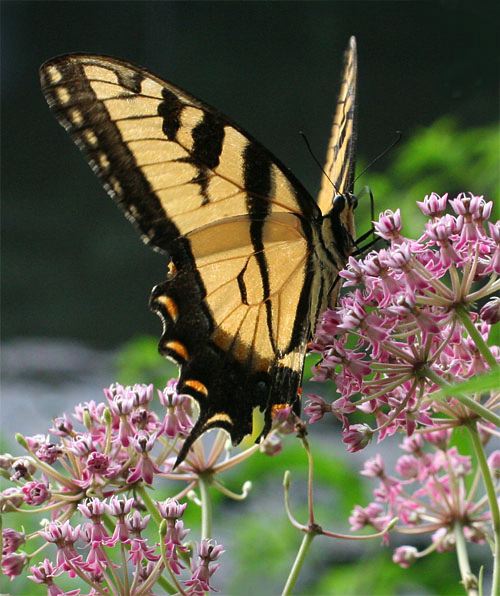
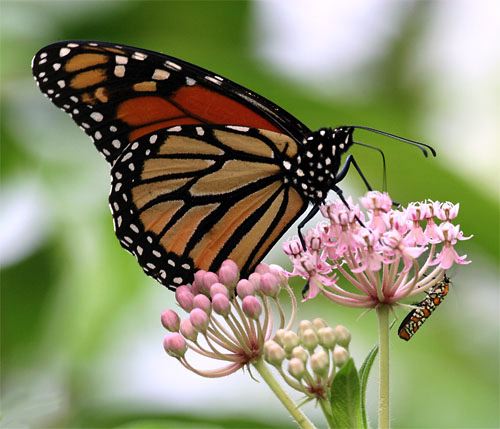
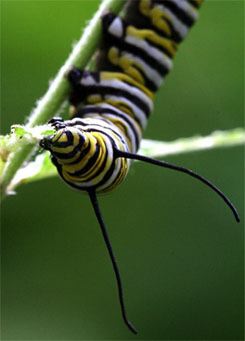 which apparently is non-toxic--and they lay their eggs on the plant. Larvae that hatch are impervious to milkweed's toxins and consume its foliage with impunity, accumulating alkaloids and cardenolides in their conspicuous black, yellow, and white bodies (right). If a vertebrate predator dares to ignore the Monarch caterpillars' brightly colored warning signals, it typically vomits soon after ingestion and is disinclined to repeat its mistake. (Interestingly, Monarchs retain milkweed toxins when they metamorphose into butterflies, which also helps reduce predation on the adults. As might be expected, a few tropical birds such as Black-headed Grosbeaks and Black-backed Orioles have evolved with tolerance to cardenolides and eat large numbers of adult Monarchs on their traditional wintering grounds in Mexico. The same seems to be true for the Mexican race of the Black-eared Mouse, Peromyscus melanotis, which can consume toxic butterflies without distress. We're unaware of any vertebrate predator in the U.S. that has such tolerances.)
which apparently is non-toxic--and they lay their eggs on the plant. Larvae that hatch are impervious to milkweed's toxins and consume its foliage with impunity, accumulating alkaloids and cardenolides in their conspicuous black, yellow, and white bodies (right). If a vertebrate predator dares to ignore the Monarch caterpillars' brightly colored warning signals, it typically vomits soon after ingestion and is disinclined to repeat its mistake. (Interestingly, Monarchs retain milkweed toxins when they metamorphose into butterflies, which also helps reduce predation on the adults. As might be expected, a few tropical birds such as Black-headed Grosbeaks and Black-backed Orioles have evolved with tolerance to cardenolides and eat large numbers of adult Monarchs on their traditional wintering grounds in Mexico. The same seems to be true for the Mexican race of the Black-eared Mouse, Peromyscus melanotis, which can consume toxic butterflies without distress. We're unaware of any vertebrate predator in the U.S. that has such tolerances.)